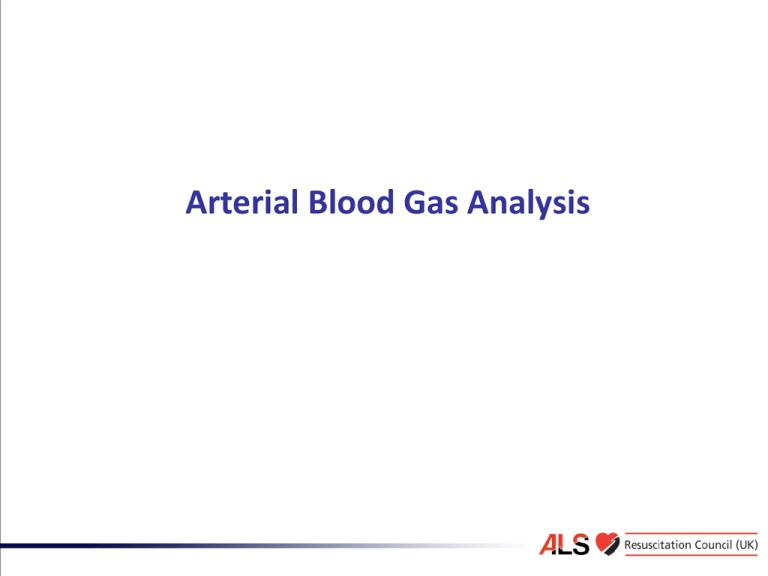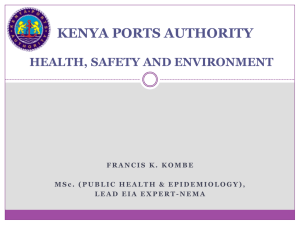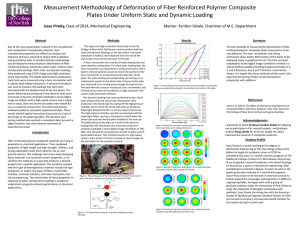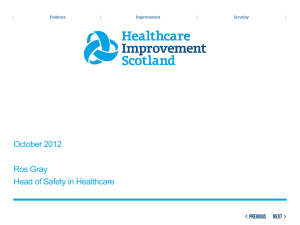
Arterial Blood Gas Analysis
Learning outcomes
By the end of this session you should understand:
• The normal ranges for arterial blood gas values
• How to use the 5-step approach to arterial blood gas
interpretation
• Some of the common causes of arterial blood gas abnormalities
and what to do to correct them
5-step approach to
arterial blood gas interpretation
5-step approach to
arterial blood gas interpretation
1. How is the patient?
•
Will provide useful clues to help with interpretation of the results
5-step approach to
arterial blood gas interpretation
1. How is the patient?
•
Will provide useful clues to help with interpretation of the results
2. Assess oxygenation
•
•
Is the patient hypoxaemic?
The PaO2 should be > 10 kPa (75 mmHg) breathing air and about 10 kPa
less than the % inspired concentration
5-step approach to
arterial blood gas interpretation
1. How is the patient?
•
Will provide useful clues to help with interpretation of the results
2. Assess oxygenation
•
•
Is the patient hypoxaemic?
The PaO2 should be > 10 kPa (75 mmHg) breathing air and about 10 kPa
less than the % inspired concentration
3. Determine the pH (or H+ concentration)
•
Is the patient acidaemic; pH < 7.35 (H+ > 45 nmol l-1)
•
Is the patient alkalaemic; pH > 7.45 (H+ < 35 nmol l-1) respiratory
component
5-step approach to
arterial blood gas interpretation
1. How is the patient?
•
Will provide useful clues to help with interpretation of the results
2. Assess oxygenation
•
•
Is the patient hypoxaemic?
The PaO2 should be > 10 kPa (75 mmHg) breathing air and about 10 kPa
less than the % inspired concentration
3. Determine the pH (or H+ concentration)
•
•
Is the patient acidaemic; pH < 7.35 (H+ > 45 nmol l-1)
Is the patient alkalaemic; pH > 7.45 (H+ < 35 nmol l-1)
4. Determine the respiratory component
•
•
If the pH < 7.35, is the PaCO2 > 6.0 kPa (45 mmHg) – respiratory acidosis
If the pH > 7.45, is the PaCO2 < 4.7 kPa (35 mmHg) – respiratory alkalosis
5-step approach to
arterial blood gas interpretation
1. How is the patient?
•
Will provide useful clues to help with interpretation of the results
2. Assess oxygenation
•
•
Is the patient hypoxaemic?
The PaO2 should be > 10 kPa (75 mmHg) breathing air and about 10 kPa
less than the % inspired concentration
3. Determine the pH (or H+ concentration)
•
•
Is the patient acidaemic; pH < 7.35 (H+ > 45 nmol l-1)
Is the patient alkalaemic; pH > 7.45 (H+ < 35 nmol l-1)
4. Determine the respiratory component
•
•
If the pH < 7.35, is the PaCO2 > 6.0 kPa (45 mmHg) – respiratory acidosis
If the pH > 7.45, is the PaCO2 < 4.7 kPa (35 mmHg) – respiratory alkalosis
5. Determine the metabolic component
•
•
If the pH < 7.35, is the HCO3- < 22 mmol l-1 (base excess < -2 mmol l-1) –
metabolic acidosis
If the pH > 7.45, is the HCO3- > 26 mmol l-1 (base excess > +2 mmol l-1) –
metabolic alkalosis
Case study 1
Initial Information
A 21-year-old woman is thrown from her horse at a local event. On
the way to hospital she has become increasingly drowsy and the
paramedics have inserted an oropharyngeal airway and given highflow oxygen via a face-mask. An arterial blood gas sample has been
taken.
Case study 1 (continued)
Initial Information
A 21-year-old woman is thrown from her horse at a local event. On
the way to hospital she has become increasingly drowsy and the
paramedics have inserted an oropharyngeal airway and given highflow oxygen via a face-mask. An arterial blood gas sample has been
taken.
• Step 1: How is the patient?
Case study 1 (continued)
Initial Information
A 21-year-old woman is thrown from her horse at a local event. On
the way to hospital she has become increasingly drowsy and the
paramedics have inserted an oropharyngeal airway and given highflow oxygen via a face-mask. An arterial blood gas sample has been
taken.
• Step 1: How is the patient?
• The reduced level of consciousness will impair oxygenation and
ventilation, causing an increased PaCO2 , a respiratory acidosis
Case study 1 (continued)
Initial Information
A 21-year-old woman is thrown from her horse at a local event. On
the way to hospital she has become increasingly drowsy and the
paramedics have inserted an oropharyngeal airway and given highflow oxygen via a face-mask. An arterial blood gas sample has been
taken.
• Step 1: How is the patient?
• The reduced level of consciousness will impair oxygenation and
ventilation, causing an increased PaCO2 , a respiratory acidosis
• There is unlikely to be much compensation (change in bicarbonate)
because of the acuteness of the situation
Case study 1 (continued)
• Arterial blood gas analysis reveals:
Inspired oxygen
PaO2
pH
PaCO2
Bicarbonate
Base excess
18.8 kPa
7.19
10.2 kPa
23.6 mmol l-1
-2.4 mmol l-1
• What are you going to do now?
40% (FiO2 0.4)
normal values
> 10 kPa (75 mmHg) on air
7.35 – 7.45
4.7 – 6.0 kPa
22 – 26 mmol l-1
+/- 2 mmol l-1
Case study 1 (continued)
• Arterial blood gas analysis reveals:
Inspired oxygen
PaO2
pH
PaCO2
Bicarbonate
Base excess
18.8 kPa
7.19
10.2 kPa
23.6 mmol l-1
-2.4 mmol l-1
40% (FiO2 0.4)
normal values
> 10 kPa (75 mmHg) on air
7.35 – 7.45
4.7 – 6.0 kPa
22 – 26 mmol l-1
+/- 2 mmol l-1
• What are you going to do now?
• Step 2: Assess oxygenation
• Is the patient hypoxaemic?
• The PaO2 should be about 10 kPa less than the % inspired concentration
Case study 1 (continued)
• Arterial blood gas analysis reveals:
Inspired oxygen
PaO2
pH
PaCO2
Bicarbonate
Base excess
18.8 kPa
7.19
10.2 kPa
23.6 mmol l-1
-2.4 mmol l-1
• What are you going to do now?
40% (FiO2 0.4)
normal values
> 10 kPa (75 mmHg) on air
7.35 – 7.45
4.7 – 6.0 kPa
22 – 26 mmol l-1
+/- 2 mmol l-1
Case study 1 (continued)
• Arterial blood gas analysis reveals:
Inspired oxygen
PaO2
pH
PaCO2
Bicarbonate
Base excess
18.8 kPa
7.19
10.2 kPa
23.6 mmol l-1
-2.4 mmol l-1
40% (FiO2 0.4)
normal values
> 10 kPa (75 mmHg) on air
7.35 – 7.45
4.7 – 6.0 kPa
22 – 26 mmol l-1
+/- 2 mmol l-1
• What are you going to do now?
• Step 3: Determine the pH (or H+ concentration)
• Is the patient acidaemic; pH < 7.35?
• Is the patient alkalaemic; pH > 7.45?
Case study 1 (continued)
• Arterial blood gas analysis reveals:
Inspired oxygen
PaO2
pH
PaCO2
Bicarbonate
Base excess
18.8 kPa
7.19
10.2 kPa
23.6 mmol l-1
-2.4 mmol l-1
• What are you going to do now?
40% (FiO2 0.4)
normal values
> 10 kPa (75 mmHg) on air
7.35 – 7.45
4.7 – 6.0 kPa
22 – 26 mmol l-1
+/- 2 mmol l-1
Case study 1 (continued)
• Arterial blood gas analysis reveals:
Inspired oxygen
PaO2
pH
PaCO2
Bicarbonate
Base excess
18.8 kPa
7.19
10.2 kPa
23.6 mmol l-1
-2.4 mmol l-1
40% (FiO2 0.4)
normal values
> 10 kPa (75 mmHg) on air
7.35 – 7.45
4.7 – 6.0 kPa
22 – 26 mmol l-1
+/- 2 mmol l-1
• What are you going to do now?
• Step 4: Determine the respiratory component
• If the pH < 7.35, is the PaCO2 > 6.0 kPa (45 mmHg)? – respiratory acidosis
• If the pH > 7.45, is the PaCO2 < 4.7 kPa (35 mmHg)? – respiratory alkalosis
Case study 1 (continued)
• Arterial blood gas analysis reveals:
Inspired oxygen
PaO2
pH
PaCO2
Bicarbonate
Base excess
18.8 kPa
7.19
10.2 kPa
23.6 mmol l-1
-2.4 mmol l-1
• What are you going to do now?
40% (FiO2 0.4)
normal values
> 10 kPa (75 mmHg) on air
7.35 – 7.45
4.7 – 6.0 kPa
22 – 26 mmol l-1
+/- 2 mmol l-1
Case study 1 (continued)
• Arterial blood gas analysis reveals:
Inspired oxygen
PaO2
pH
PaCO2
Bicarbonate
Base excess
18.8 kPa
7.19
10.2 kPa
23.6 mmol l-1
-2.4 mmol l-1
40% (FiO2 0.4)
normal values
> 10 kPa (75 mmHg) on air
7.35 – 7.45
4.7 – 6.0 kPa
22 – 26 mmol l-1
+/- 2 mmol l-1
• What are you going to do now?
• Step 5: Determine the metabolic component
• If the pH < 7.35, is the HCO3- < 22 mmol l-1 (base excess < -2 mmol l-1) –
metabolic acidosis
• If the pH > 7.45, is the HCO3- > 26 mmol l-1 (base excess > +2 mmol l-1) –
metabolic alkalosis
Case study 1 (continued)
• Arterial blood gas analysis reveals:
Inspired oxygen
PaO2
pH
PaCO2
Bicarbonate
Base excess
18.8 kPa
7.19
10.2 kPa
23.6 mmol l-1
-2.4 mmol l-1
40% (FiO2 0.4)
normal values
> 10 kPa (75 mmHg) on air
7.35 – 7.45
4.7 – 6.0 kPa
22 – 26 mmol l-1
+/- 2 mmol l-1
In summary:
An acute respiratory acidosis with impaired oxygenation.
Case study 2
Initial Information
A 60-year-old man is brought to the ED after a witnessed out-ofhospital cardiac arrest. The paramedics arrived after 7 min, during
which CPR had not been attempted. His initial rhythm was VF and the
paramedics subsequently restored a spontaneous circulation after
the 3rd shock.
On arrival:
- Intubated, ventilated with 50% oxygen
- HR 120 min-1, BP 150/95 mmHg
- Comatose (GCS 3)
• Use the 5-step approach to analyse the results of an arterial blood
sample
Case study 2 (continued)
• Arterial blood gas analysis reveals:
Inspired oxygen
50% (FiO2 0.5)
normal values
PaO2
7.5 kPa (56 mmHg)
> 10 kPa (75 mmHg) on air
pH
7.10
7.35 – 7.45
PaCO2
6.2 kPa (47 mmHg)
4.7 – 6.0 kPa (35 – 45 mmHg)
HCO3-
14 mmol l-1
22 – 26 mmol l-1
BE
- 10 mmol l-1
+/- 2 mmol l-1
Case study 2 (continued)
• Arterial blood gas analysis reveals:
Inspired oxygen
50% (FiO2 0.5)
normal values
PaO2
7.5 kPa (56 mmHg)
> 10 kPa (75 mmHg) on air
pH
7.10
7.35 – 7.45
PaCO2
6.2 kPa (47 mmHg)
4.7 – 6.0 kPa (35 – 45 mmHg)
HCO3-
14 mmol l-1
22 – 26 mmol l-1
BE
- 10 mmol l-1
+/- 2 mmol l-1
In summary:
This is a typical ABG result after prolonged cardiac arrest.
There is a mixed metabolic and respiratory acidosis – the
predominant component is metabolic, with significant impairment
of oxygenation.
Case study 3
Initial Information
A 65-year-old man with severe COPD has been found collapsed in the
respiratory unit. On initial assessment by the ward nurse he is apnoeic
but has an easily palpable carotid pulse. The nurse is attempting to
ventilate his lungs with a bag-mask and supplemental oxygen (with
reservoir) and has called the cardiac arrest team.
On arrival:
- Oropharyngeal airway, ventilated with bag-mask, oxygen at 15 l min-1
- Carotid pulse palpable, 90 min-1, SpO2 99%
- Comatose (GCS 3)
• Use the 5-step approach to analyse the results of an arterial blood
sample
Case study 3 (continued)
• Arterial blood gas analysis reveals:
Inspired oxygen
85% (FiO2 0.85) estimated
normal values
PaO2
19.5 kPa (147 mmHg)
> 10 kPa (75 mmHg) on air
pH
7.10
7.35 – 7.45
PaCO2
18.0 kPa (135 mmHg)
4.7 – 6.0 kPa (35 – 45 mmHg)
HCO3-
36 mmol l-1
22 – 26 mmol l-1
BE
+ 12 mmol l-1
+/- 2 mmol l-1
Case study 3 (continued)
• Arterial blood gas analysis reveals:
Inspired oxygen
85% (FiO2 0.85) estimated
normal values
PaO2
19.5 kPa (147 mmHg)
> 10 kPa (75 mmHg) on air
pH
7.10
7.35 – 7.45
PaCO2
18.0 kPa (135 mmHg)
4.7 – 6.0 kPa (35 – 45 mmHg)
HCO3-
36 mmol l-1
22 – 26 mmol l-1
BE
+ 12 mmol l-1
+/- 2 mmol l-1
In summary:
The significant acidaemia (pH 7.10) indicate an additional acute
respiratory acidosis as a result of the respiratory arrest. In the
pre-existing compensated chronic respiratory acidosis,
the pH would have been close to normal.
Case study 4
Initial Information
A 75-year-old woman is admitted to the ED following a VF cardiac
arrest, witnessed by paramedics. This had been preceded by 30 min
of severe central chest pain. Spontaneous circulation restored after
2 shocks, but the patient remained apnoeic and unresponsive. The
paramedics intubated her trachea and ventilated her with an
automatic ventilator.
On arrival:
- Tube confirmed in trachea, tidal volume of 900 ml, rate of 18 breaths
min-1, 100% oxygen
- Pulse 100 min-1, BP 90/54 mmHg
- Comatose (GCS 3)
• Use the 5-step approach to analyse the results of an arterial blood
sample
Case study 4 (continued)
• Arterial blood gas analysis reveals:
Inspired oxygen
100% (FiO2 1.0)
normal values
PaO2
25.4 kPa (192 mmHg)
> 10 kPa (75 mmHg) on air
pH
7.62
7.35 – 7.45
PaCO2
2.65 kPa (20 mmHg)
4.7 – 6.0 kPa (35 – 45 mmHg)
HCO3-
20 mmol l-1
22 – 26 mmol l-1
BE
- 4 mmol l-1
+/- 2 mmol l-1
Case study 4 (continued)
• Arterial blood gas analysis reveals:
Inspired oxygen
100% (FiO2 1.0)
normal values
PaO2
25.4 kPa (192 mmHg)
> 10 kPa (75 mmHg) on air
pH
7.62
7.35 – 7.45
PaCO2
2.65 kPa (20 mmHg)
4.7 – 6.0 kPa (35 – 45 mmHg)
HCO3-
20 mmol l-1
22 – 26 mmol l-1
BE
- 4 mmol l-1
+/- 2 mmol l-1
In summary:
A respiratory alkalosis, mild metabolic acidosis and
impaired oxygenation.
Case study 5
Initial Information
An 18-year-old insulin dependent diabetic is admitted to the
ED. He has been vomiting for 48 h and because he was unable
to eat, he has taken no insulin.
On arrival:
- Breathing spontaneously RR 35 min-1, oxygen 4 l min-1 via
Hudson mask, SpO2 98%
- HR 130 min-1, BP 90/65 mmHg
- GCS 12 (E3, M5, V4)
• Use the 5-step approach to analyse the results of an
arterial blood sample
Case study 5 (continued)
• Arterial blood gas analysis reveals:
Inspired oxygen
PaO2
pH
PaCO2
HCO3BE
17.0 kPa (129 mmHg)
6.89
2.48 kPa (19 mmHg)
4.7 mmol l-1
- 29.2 mmol l-1
30% (FiO2 0.3) estimated
normal values
> 10 kPa (75 mmHg) on air
7.35 – 7.45
4.7 – 6.0 kPa (35 – 45 mmHg)
22 – 26 mmol l-1
+/- 2 mmol l-1
The blood glucose is 30 mmol l-1 and there are ketones +++ in the urine
Case study 5 (continued)
• Arterial blood gas analysis reveals:
Inspired oxygen
PaO2
pH
PaCO2
HCO3BE
17.0 kPa (129 mmHg)
6.89
2.48 kPa (19 mmHg)
4.7 mmol l-1
- 29.2 mmol l-1
30% (FiO2 0.3) estimated
normal values
> 10 kPa (75 mmHg) on air
7.35 – 7.45
4.7 – 6.0 kPa (35 – 45 mmHg)
22 – 26 mmol l-1
+/- 2 mmol l-1
The blood glucose is 30 mmol l-1 and there are ketones +++ in the urine
In summary:
These blood gas results are consistent with severe diabetic
ketoacidosis. Further evidence is the presence of ketones in his
urine and the very high blood glucose. There is a primary
metabolic acidosis with partial compensation provided by the
respiratory alkalosis.
Case study 6
Initial Information
A 75-year-old man is on the surgical ward 2 days after a laparotomy
for a perforated sigmoid colon secondary to diverticular disease. He
has become increasingly hypotensive over the last 6 h, despite
1000 ml 0.9% saline.
On arrival:
-
RR 35 min-1, SpO2 92% on 6 l min-1 oxygen via facemask
HR 120 min-1, sinus tachycardia, warm peripheries, BP 70/40 mmHg
Urine output 90 ml in the last 6 h
GCS 13 (E3, M6, V4)
• Use the 5-step approach to analyse the results of an arterial blood
sample
Case study 6 (continued)
• Arterial blood gas analysis reveals:
Inspired oxygen
40% (FiO2 0.4) estimated
normal values
PaO2
8.2 kPa (62 mmHg)
> 10 kPa (75 mmHg) on air
pH
7.17
7.35 – 7.45
PaCO2
4.5 kPa (34 mmHg)
4.7 – 6.0 kPa (35 – 45 mmHg)
HCO3-
12 mmol l-1
22 – 26 mmol l-1
BE
- 15 mmol l-1
+/- 2 mmol l-1
Case study 6 (continued)
• Arterial blood gas analysis reveals:
Inspired oxygen
40% (FiO2 0.4) estimated
normal values
PaO2
8.2 kPa (62 mmHg)
> 10 kPa (75 mmHg) on air
pH
7.17
7.35 – 7.45
PaCO2
4.5 kPa (34 mmHg)
4.7 – 6.0 kPa (35 – 45 mmHg)
HCO3-
12 mmol l-1
22 – 26 mmol l-1
BE
- 15 mmol l-1
+/- 2 mmol l-1
In summary:
There is a primary metabolic acidosis with slight compensation
provided by the mild respiratory alkalosis. The degree of this is
probably limited by the presence of an acute abdomen. The most
likely diagnosis is sepsis syndrome secondary to intra-abdominal
infection. The plasma lactate would be elevated.
Any questions?
Summary
This workshop has covered:
• The terms used to describe the results of arterial blood gas
•
•
•
•
analysis
The normal ranges for arterial blood gas values
How respiration and metabolism are linked
How to use the 5-step approach to arterial blood gas
interpretation
Some of the common causes of arterial blood gas abnormalities
and what to do to correct them
Advanced Life Support Course
Slide set
All rights reserved
© Resuscitation Council (UK) 2010







